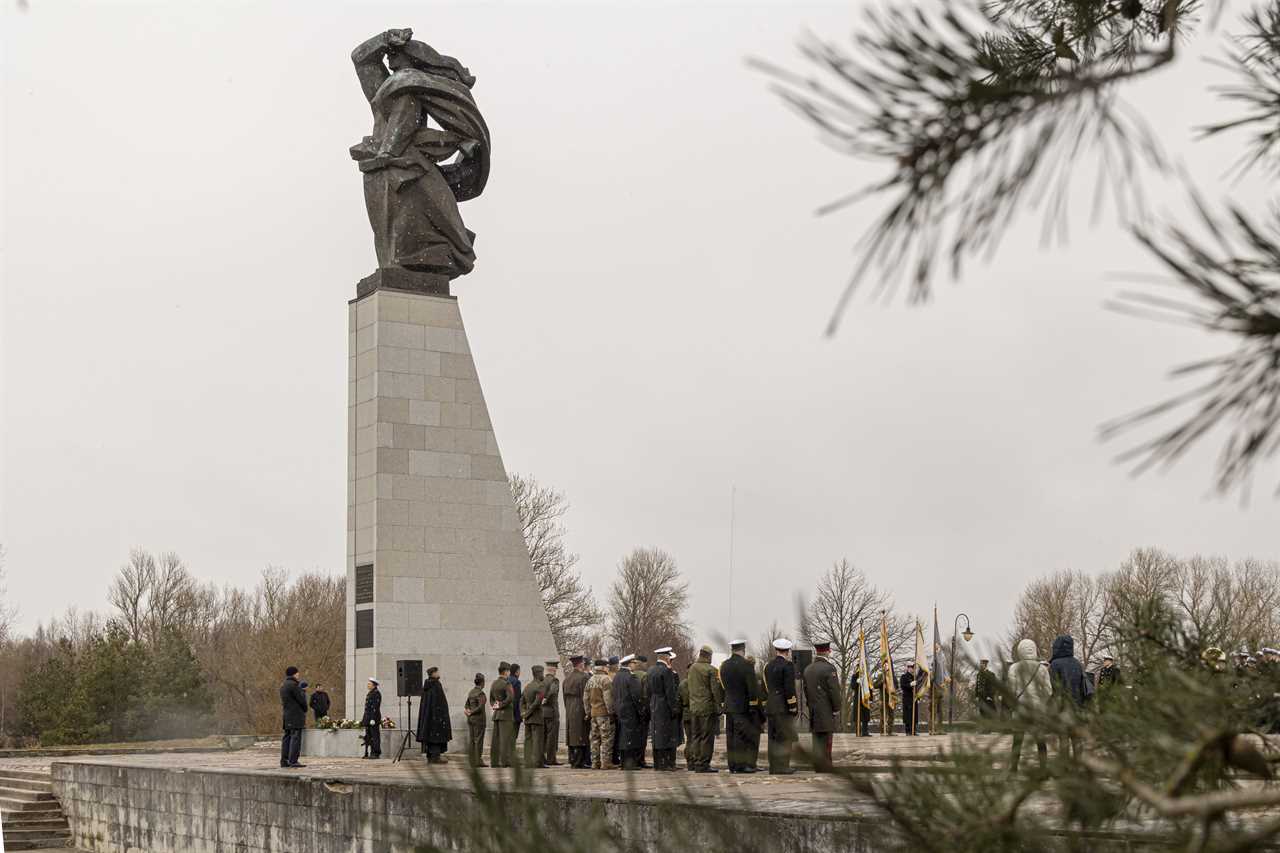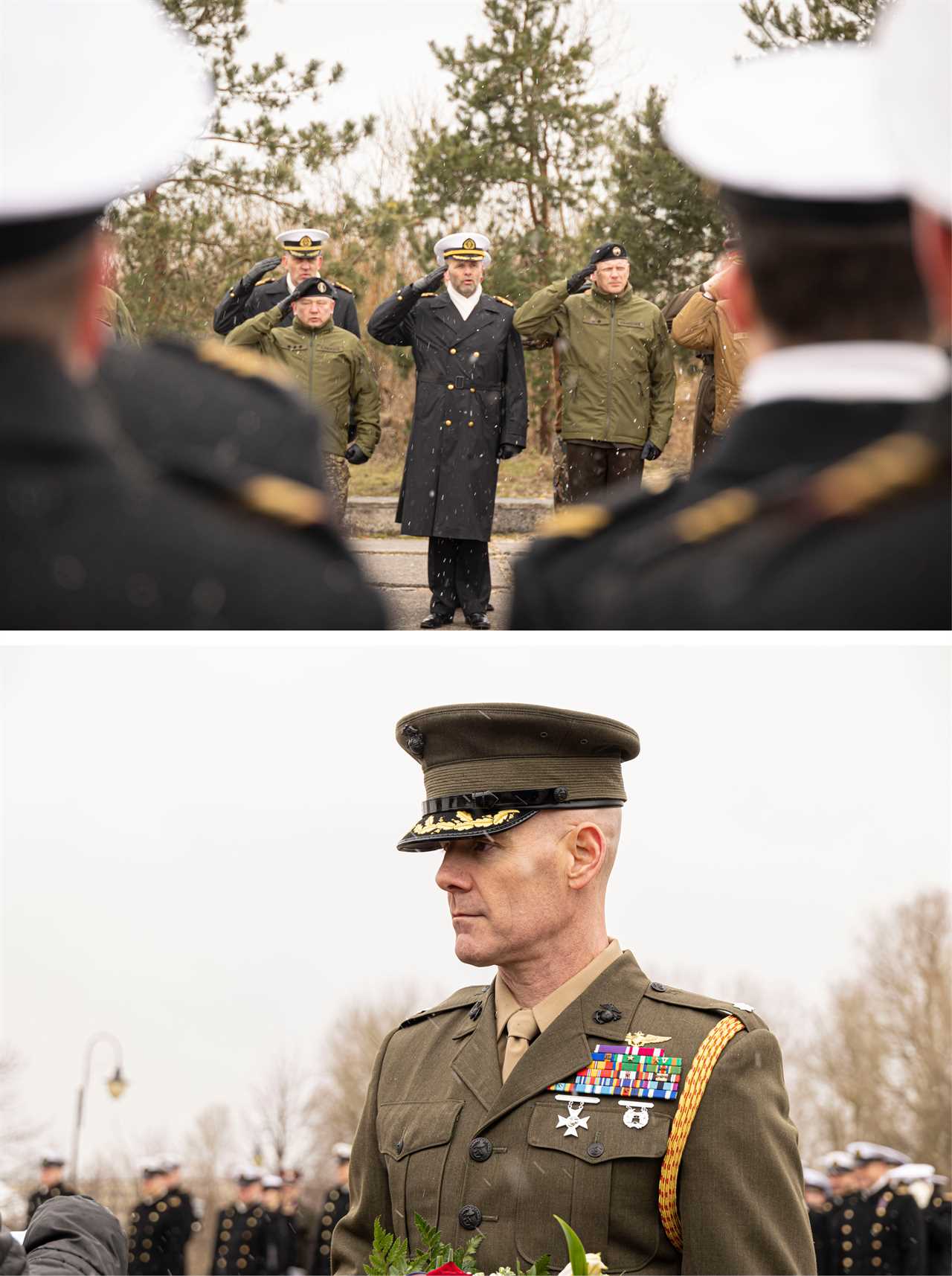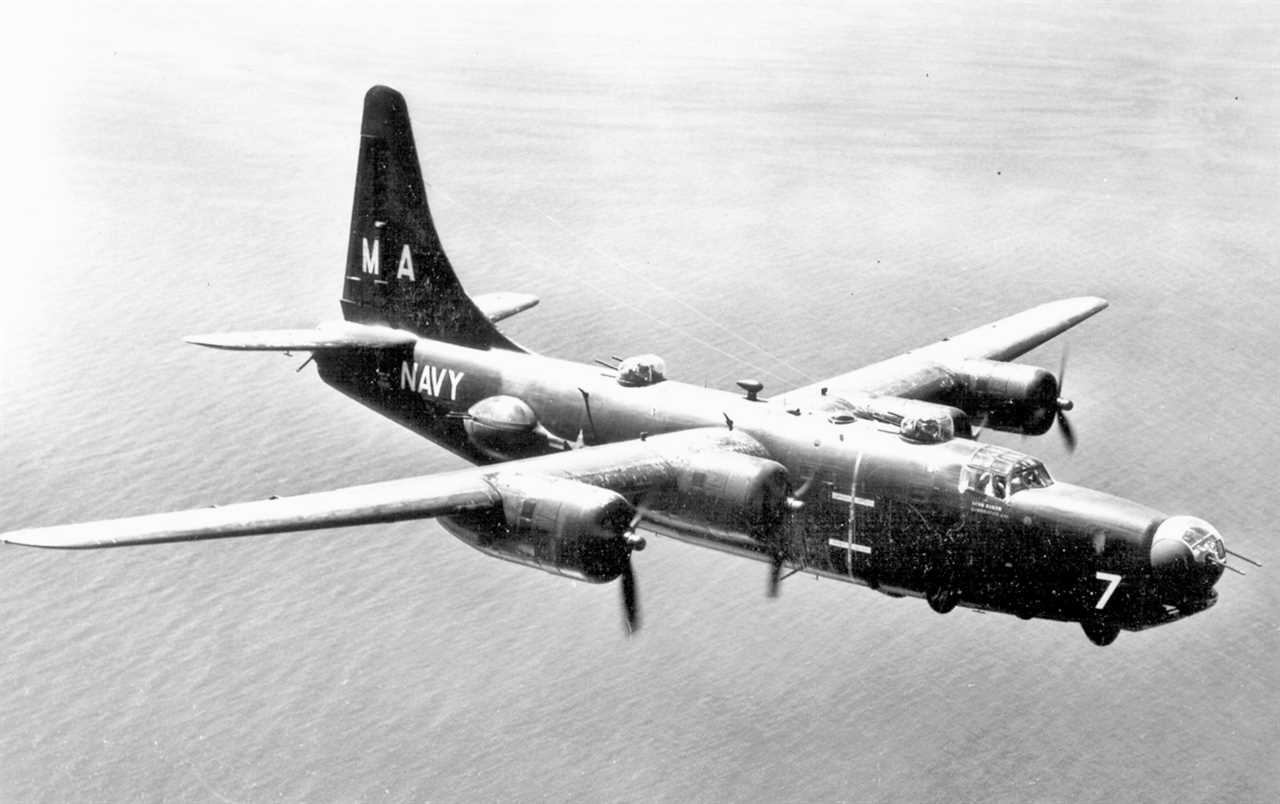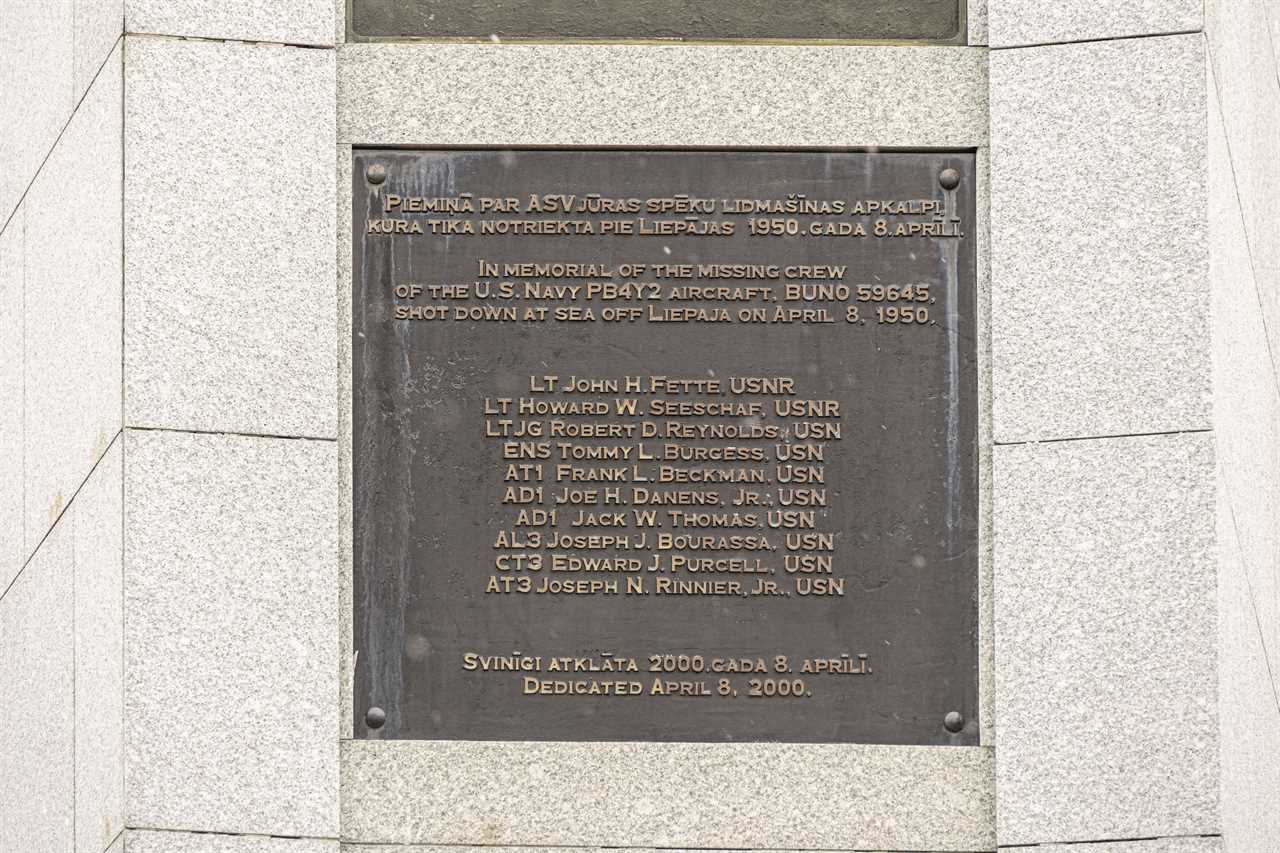
Seventy-three years ago this week, the first lethal clash of the Cold War lit up the skies over the Baltic Sea. Ten American airmen on a secret — and well-disguised — mission disappeared, never to be heard from again. Most likely you have never heard about them. But at a time when Russia and the U.S. once again have daggers drawn, their story is one we cannot afford to forget.
Latvia certainly hasn’t forgotten. Every April the U.S. ambassador to Riga, along with representatives of the Latvian government and military, presides over a solemn ceremony on the beach promenade of Liepāja, a coastal city overlooking the Baltic Sea, to honor the 10-man crew of the U.S. Navy Privateer reconnaissance aircraft PB4Y-2, flight 59645, which was shot down by four Soviet jets on April 8, 1950. This year’s commemoration took place on Thursday, featuring a speech by Christopher Robinson, the new American ambassador. “This commemoration is particularly relevant in light of our renewed confrontation with authoritarianism,” he told me.

Indeed, a new Cold War between the U.S. and Russia is heating up in the skies overlooking the same foam-specked waves in which the U.S. Navy PB4Y-2 went down. Two weeks before the ceremony, a Russian jet intercepted two U.S. B-52 bombers flying nearby. Just a week before that aerial tangle, in the first known military encounter between Russia and the U.S. since the invasion of Ukraine began, Russian jets playing chicken with an unmanned American surveillance drone over the Black Sea caused it to crash. Fortunately, there were no casualties in either incident. The Russian SU-45 tailing the two venerable U.S. bombers over the Baltic, which the Kremlin claimed were flying toward Russia, disengaged. The U.S. drone that Vladimir Putin’s eager eagles — as his predecessor, Joseph Stalin, used to call his pilots — caused to crash was remotely piloted.
Nevertheless, Liepāja mayor Gunars Ansins noted the troubling parallels between past and present: “In light of today’s events in Ukraine, we see that [the] values [fallen soldiers] fought for — freedom, security, democracy — are more relevant than ever.”
What led those brave men to their deaths off the coast of Latvia that day, bringing the U.S. to the precipice of a hot war all those decades ago? What exactly was the real purpose of flight 59645, and what happened to men on board?
Three quarters of a century later, none of these things are truly clear.

One of our aircraft is missing. That was the essence of the alarmed, all-points message that went out from the NATO air force base at Copenhagen, Denmark, on the afternoon of April 8, 1950, after the converted Navy PB4Y-2 Privateer reconnaissance aircraft, also known as “Turbulent Turtle,” went missing.
The U.S. plane was on a “routine” “navigational flight” from Wiesbaden, Germany, to the NATO air force base at Copenhagen, according to the opaque statement issued by the Pentagon the following day, buried in a New York Times","link":{"target":"NEW","attributes":[],"url":"https://timesmachine.nytimes.com/timesmachine/1950/04/10/94256184.html?pageNumber=12","_id":"00000187-65bf-de81-a597-f7ffce6b0000","_type":"33ac701a-72c1-316a-a3a5-13918cf384df"},"_id":"00000187-65bf-de81-a597-f7ffce6b0001","_type":"02ec1f82-5e56-3b8c-af6e-6fc7c8772266"}">short article on page 12 of the New York Times.
The mystery behind the missing plane was cleared up — or, more accurately, partly cleared up — on April 11, when the Kremlin announced that a B-29 Superfortress had disappeared over the Baltic Sea near Liepāja in occupied Latvia after it had putatively intruded on Soviet air space. According to Moscow, the offending plane had been intercepted by Soviet fighters after it had refused their orders to land. Instead of obeying, the bomber had opened fire, according to the Soviets, forcing them to return fire.
The State Department and Department of Defense continued to claim that the plane was on a routine navigational flight, castigating the Kremlin for its apparent refusal to assist its former World War II ally in the search for the missing Privateer crew. “The attitude of the Soviet government shows clearly the insincerity of its oft-proclaimed desire for peaceful relations with the United States and the non-Soviet world,” protested Michael McDermott, chief spokesperson for the State Department.
The USSR’s failure to take part in the search, the livid American continued, “or to exhibit the slightest evidence of concern [for them] showed an astonishing lack of common international courtesy and an unusual disregard of the loss of human life.”
But the New York Times was skeptical of the original American position regarding flight 59645. “The specific role of the plane remain[s] something of a riddle,” the paper reported on April 11. “In spite of a statement that the mission was routine,” it continued dubiously, “observers noted that the crew was composed predominantly of special technicians, including electronic specialists.”
In fact, both Moscow and Washington were lying. The Turbulent Turtle was indeed on an electronic reconnaissance mission.
It would take a quarter of a century for the U.S. government to admit it, however as the Naval Investigative Board, which looked into the episode, noted in a report declassified in 1975, the Privateer was engaged in a “special electronic search project mission.”
“Ferret flights,” these spy missions used to be called — reconnaissance missions designed to locate Soviet radar stations. In case war broke out with the USSR, which appeared increasingly possible at that feral juncture of history, the data gathered on such flights would be critical.

These difficult, hair-raising flights, manned entirely by volunteers, were not for the faint-hearted. “Crews were jammed into cramped compartments where they huddled over radar screens and electronic monitoring devices,” Air & Space Magazine","link":{"target":"NEW","attributes":[],"url":"https://www.smithsonianmag.com/air-space-magazine/secret-casualties-of-the-cold-war-180967122/","_id":"00000187-65bf-de81-a597-f7ffce6b0002","_type":"33ac701a-72c1-316a-a3a5-13918cf384df"},"_id":"00000187-65bf-de81-a597-f7ffce6b0003","_type":"02ec1f82-5e56-3b8c-af6e-6fc7c8772266"}">wrote air force historian Paul Glenshaw in a 2017 Air & Space Magazine article. The purpose of these dangerous missions was to trigger enemy radar installations so as to confirm their location.
Moscow was also lying. The Kremlin knew — or had to know — that the plane its pilots shot down was not a B-29 as it claimed, but had been converted from the much smaller B-24. The massive silhouette of the B-29 Superfortress, the same heavy bomber that had dropped the first atomic bombs over Hiroshima and Nagasaki, was completely different from the medium-sized B-24 Liberator upon which the Privateer was based. Moreover, the Soviets themselves actually possessed a number of B-29s that had been forced to land on their territory.
Even more ridiculous was the charge that the “Turtle” had fired at the Soviets: Like all spy planes, the Privateer had deliberately been stripped of ordnance. The only weapon on board, according to Glenshaw, was the .38 caliber belonging to the pilot, Lieutenant Commander John Fette.
Another point of disagreement was the exact location of the aerial confrontation, which Washington insisted took place in international waters. Back and forth went the dueling statements, much like the ones that the two sides recently exchanged after the crash of the U.S. drone over the Black Sea, with Washington declaring that the downed drone was in international air space, which Moscow denied.
The only thing that was and is still clear, is that something went badly wrong — at least from the U.S. Air Force’s point of view. For his part, Stalin was so pleased by the performance of both the radar men who detected the U.S. spy plane and the pilots who blew it out of the skies that he awarded them medals — just as their successors who crashed the U.S. drone last month were.
And so the increasingly frustrating search for the U.S. craft continued. On April 15, a week after the incident, searchers spotted a lifeboat from the Privateer, pointing to the probability that the aircraft had not broken up, but had made a soft landing. Ten days later, on April 25, the captain of a Swedish fishing vessel found an airplane wheel in its net. The wheel, identified as the nose wheel of a Privateer, had been pierced by a machine gun bullet.
Still no sign of the captain, John Fette, and his crew.
By then Fette and his nine men had been declared missing in action, and their shocked and puzzled families, who had been in the dark about the missing flight, had been notified.
That same day, Navy Secretary Francis Matthews, at the joint behest of President Harry Truman and Congress, awarded the Distinguished Flying Cross to Fette and his men “for performing assigned tasks with courage and skills on a peacetime mission,” while maintaining discreet silence about the actual nature of that mission.
The Kremlin, anxious to make maximum propaganda use of the episode, certainly wasn’t discreet — possibly on the basis of new evidence it had uncovered during its parallel search — asserting that the Privateer’s objective had been “photographing [Soviet] defense installations.” Which could be true.
Which might not have been far off the mark. Had the Soviets recovered some incriminating flotsam from the fallen plane?
And, incidentally, what happened to the men themselves? Had the Russians captured some of the crew, as rumors and reports by persons formerly detained in the Soviet gulags suggested? The State Department reportedly sent a pointed demarche to Moscow about the matter in 1956, as a 1992 report by the Department of Defense POW/MIA department notes. There is no reliable evidence that any of the men survived the crash or were taken prisoner. Nevertheless, the Defense POW/MIA Accounting Agency has not closed its books on the incident.
Whatever happened out there in the skies over the Baltic near Liepāja, a dangerous line had been crossed. A new war — a “cold war,” including a low-key but very real shooting war, was on, as Navy Secretary Matthews told a meeting of the Manhattan chapter of the Reserve Officers Association on April 24, the night before the men of the Turbulent Turtle were posthumously decorated, New York Times","link":{"target":"NEW","attributes":[],"url":"https://timesmachine.nytimes.com/timesmachine/1950/04/26/87098938.html?pageNumber=10","_id":"00000187-65bf-de81-a597-f7ffce6c0002","_type":"33ac701a-72c1-316a-a3a5-13918cf384df"},"_id":"00000187-65bf-de81-a597-f7ffce6c0003","_type":"02ec1f82-5e56-3b8c-af6e-6fc7c8772266"}">according to the New York Times. Soon the press would stop using the quotes around “cold war” and begin capitalizing it.
The Cold War would continue for 50 years. And there would be more casualties. U.S. spy planes would continue to be shot down. The most famous incident, of course, was the May 1960 shootdown by Soviet anti-aircraft missiles of the high altitude U2 spy plane piloted by Gary Powers.
Powers was fortunate. He survived his shootdown and was eventually repatriated. But most of the American airmen who were shot down by increasingly effective Soviet air defenses were not so fortunate — nor were their families. All in all, an estimated 200 men, including the men of the Turbulent Turtle, went down with their spy craft in this all-but-forgotten theater of the Cold War, which ended with the break-up of the USSR in 1991, when the former so-called Latvian Socialist Social Republic regained its independence.

No less than 126 airmen lost during the Cold War are still unaccounted for and officially listed as MIA, according to the Pentagon.
Most Americans may have forgotten these long-ago incidents, but the crew’s families remember. In 2015, Kathy Fiffick, who is the niece of pilot John Fette, and Paul, her husband, attended the annual commemoration in Liepāja.
The government and people of Latvia remember, too. “Today marks 73 years since a U.S. aircraft was shot down by Soviet military forces near Liepāja,” said Natalja Vecvagare, international policy adviser for Liepāja, at the ceremony on Thursday, “marking the first Cold War casualty in the reconnaissance war against the Soviets.”
“Eternal vigilance is the price of freedom,” she continued, quoting Thomas Jefferson. “And today, when the world ‘war’ has so many faces — conventional, informational, cyber, electronic — we all need to stay extremely vigilant to protect our freedom.”

Ambassador Robinson seconded those sentiments in his own closing remarks. “We have not forgotten the sacrifices of those who came before us,” he declared. “We honor their memory with our pledge to defend NATO’s territory with the full force of U.S. and Allied power, and in supporting the people of Ukraine in their fight against Russian tyranny.”
“We stand for the same values as the Latvians,” the visibly moved ambassador told me afterward. As he spoke, two shadows appeared overhead. For a moment, I could have sworn that they were Russian jets.
But no, they were only two patrolling sea gulls.
Meanwhile, the Pentagon’s official position on the status of the Turbulent Turtle remains the same: One of our aircraft is missing.
----------------------------------------
By: Gordon F. Sander
Title: When Moscow Shot Americans Out of the Sky
Sourced From: www.politico.com/news/magazine/2023/04/09/russia-u-s-air-cold-war-00090967
Published Date: Sun, 09 Apr 2023 06:00:00 EST
Did you miss our previous article...
https://consumernewsnetwork.com/politics-us/gold-rush-fever-true-believers-inside-the-boom-of-covid-litigation






